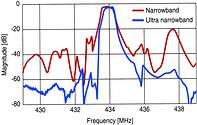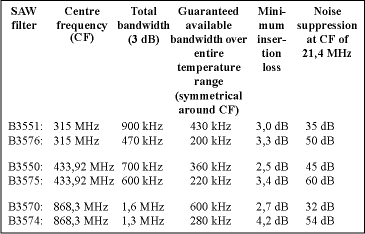
Considered sheer wizardry just a few years ago, wireless remote control is now state-of-the-art. Doors open as if by magic, equipment is switched on and off from a distance without the slightest interference to other electronic circuitry or triggering the wrong target devices. Radio-controlled applications for transmission of data over short distances are commonly based on short range devices (SRDs) or low-power devices (LPDs) and ultra narrowband SAW filters from Epcos are key components of this wireless revolution.
Various frequency bands have been assigned to these applications. Europe, for example, uses the ISM band with a centre frequency of 433,92 MHz or the new 869 MHz band. The outstanding advantage of these systems is their simple and economical design. Performance and reliability can be tailored to target applications.

Systems based on SRDs are typically found in automotive electronics, such as remote keyless entry and tyre pressure monitoring, in alarm systems, electrical installations in buildings, and telemetry. The basic structure of all SRD systems is similar. The coded control signal is generated by a SAW (surface acoustic wave) resonator/PLL-stabilised oscillator, transmitted and then demodulated by a superheterodyne receiver (Figures 1 and 2).

The selectivity of the receiver is mainly determined by the IF filter, while the RF front-end filter determines its large-signal/image-frequency stability. The receiver IC itself has only a low large-signal stability for reasons of power consumption. Image frequency rejection mixers are found in few if any circuit designs. The ISM band is exposed to strong interference sources in its immediate vicinity, such as the new European digital trunked network TETRA (410 to 430 MHz), as well as to sporadic interference at high power levels by amateur radio operators. Noise immunity requirements in SRD receiver systems are becoming tougher as automotive manufacturers demand greater functional reliability and new approval regulations (EN 300220, EN 301489) call for minimum large-signal stability and selectivity of available bandwidth. Special EMC specifications issued by automobile manufacturers call for RF interference protection several orders of magnitude higher than prescribed in EN 300220.
This makes requirements even more rigorous. All major automobile manufacturers in Europe are using narrowband SAW front-end filters for protection against interference. Narrowband SAW front-end filters on quartz substrates are particularly effective in reducing nearby interference and the image frequency (equal to the centre frequency fo ±21,4 MHz), so that the RF input stage does not become saturated. The receiver retains its full sensitivity for the centre frequency fo, even though it is surrounded by strong interference signals.
Filters from this family (eg B3550) have a total bandwidth (at 3 dB) of about 800 kHz and a typical selectivity of 40 dB at an image frequency equal to fo ±5 MHz, which increases to about 45 dB at an image frequency equal to fo ±21,4 MHz. Far-off selectivity exceeds these values even more. The quartz substrate has the advantage of a very low temperature coefficient, so that the filter's centre frequency remains almost constant over a broad temperature range. This stability also enables total filter bandwidth to be kept narrow.

Responding to market requirements, Epcos developed a new family of ultra narrowband filters on quartz substrates with reduced total bandwidth (eg 600 kHz in the B3575). They are distinguished by considerably higher near and far-off selectivity. This was achieved by using an internal series circuit containing two filter structures. An external inductance compensates the transducer capacitances. The real part of the internal electroacoustic transducer is matched, thus ensuring power matching in the filter, low insertion loss and a flat passband.

This technology considerably increases edge steepness and selectivity (near and far-off) without increasing insertion loss unduly. The selectivity and thus the focus of the receiver on the centre frequency fo are so strong that even interference 1 MHz away from fo is extremely effectively suppressed (better than 30 dB in the B3575, centre frequency 433,92 MHz). This opens the door to new designs with low intermediate frequencies of 0,5 or 1 MHz. Integration of the IF filter into the IC as an active filter structure thus offers considerable savings potential. The narrow passband of the filter means calls for an RF signal with an extremely stable frequency. This can be achieved with fine-tolerance SAW resonators (±50 kHz) or PLL-stabilised transmit systems.
A perfect circuit layout is needed to take advantage of the superior selectivity of these filters in the application. If the IC meets all requirements, many of the narrowband and ultra narrowband SAW filters from Epcos can be operated in balanced mode. The balanced drive of the input stage in the IC (LNA/mixer) produces common-mode rejection which can reduce electrical crosstalk several times over.

| Tel: | +27 11 458 9000 |
| Email: | [email protected] |
| www: | www.electrocomp.co.za |
| Articles: | More information and articles about Electrocomp |

© Technews Publishing (Pty) Ltd | All Rights Reserved